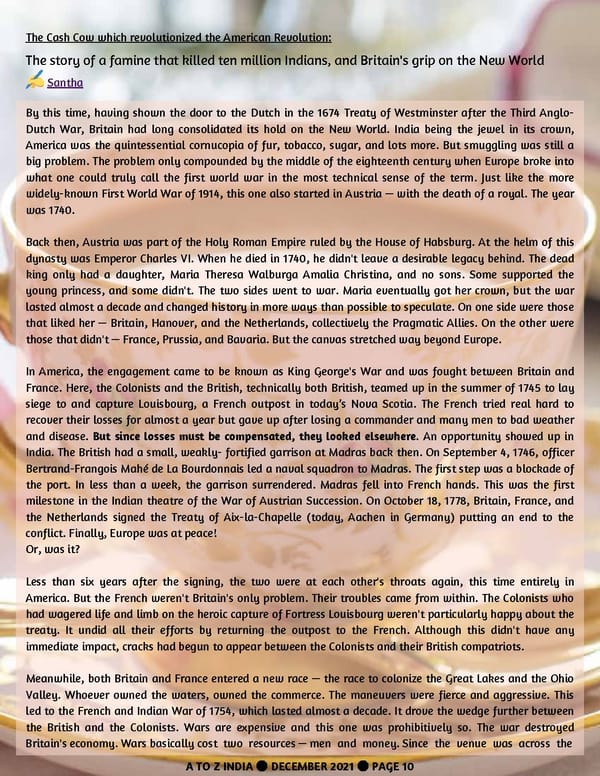The Cash Cow which revolutionized the American Revolution: The story of a famine that killed ten million Indians, and Britain's grip on the New World Santha By this time, having shown the door to the Dutch in the 1674 Treaty of Westminster after the Third Anglo- Dutch War, Britain had long consolidated its hold on the New World. India being the jewel in its crown, America was the quintessential cornucopia of fur, tobacco, sugar, and lots more. But smuggling was still a big problem. The problem only compounded by the middle of the eighteenth century when Europe broke into what one could truly call the first world war in the most technical sense of the term. Just like the more widely-known First World War of 1914, this one also started in Austria — with the death of a royal. The year was 1740. Back then, Austria was part of the Holy Roman Empire ruled by the House of Habsburg. At the helm of this dynasty was Emperor Charles VI. When he died in 1740, he didn't leave a desirable legacy behind. The dead king only had a daughter, Maria Theresa Walburga Amalia Christina, and no sons. Some supported the young princess, and some didn't. The two sides went to war. Maria eventually got her crown, but the war lasted almost a decade and changed history in more ways than possible to speculate. On one side were those that liked her — Britain, Hanover, and the Netherlands, collectively the Pragmatic Allies. On the other were those that didn't — France, Prussia, and Bavaria. But the canvas stretched way beyond Europe. In America, the engagement came to be known as King George's War and was fought between Britain and France. Here, the Colonists and the British, technically both British, teamed up in the summer of 1745 to lay siege to and capture Louisbourg, a French outpost in today’s Nova Scotia. The French tried real hard to recover their losses for almost a year but gave up after losing a commander and many men to bad weather and disease. But since losses must be compensated, they looked elsewhere. An opportunity showed up in India. The British had a small, weakly- fortified garrison at Madras back then. On September 4, 1746, officer Bertrand-Frangois Mahé de La Bourdonnais led a naval squadron to Madras. The first step was a blockade of the port. In less than a week, the garrison surrendered. Madras fell into French hands. This was the first milestone in the Indian theatre of the War of Austrian Succession. On October 18, 1778, Britain, France, and the Netherlands signed the Treaty of Aix-la-Chapelle (today, Aachen in Germany) putting an end to the conflict. Finally, Europe was at peace! Or, was it? Less than six years after the signing, the two were at each other's throats again, this time entirely in America. But the French weren't Britain's only problem. Their troubles came from within. The Colonists who had wagered life and limb on the heroic capture of Fortress Louisbourg weren't particularly happy about the treaty. It undid all their efforts by returning the outpost to the French. Although this didn't have any immediate impact, cracks had begun to appear between the Colonists and their British compatriots. Meanwhile, both Britain and France entered a new race — the race to colonize the Great Lakes and the Ohio Valley. Whoever owned the waters, owned the commerce. The maneuvers were fierce and aggressive. This led to the French and Indian War of 1754, which lasted almost a decade. It drove the wedge further between the British and the Colonists. Wars are expensive and this one was prohibitively so. The war destroyed Britain's economy. Wars basically cost two resources — men and money. Since the venue was across the A TO Z INDIA ● DECEMBER 2021 ● PAGE 10
 A TO Z INDIA - DECEMBER 21 Page 9 Page 11
A TO Z INDIA - DECEMBER 21 Page 9 Page 11